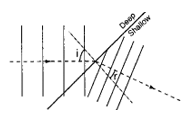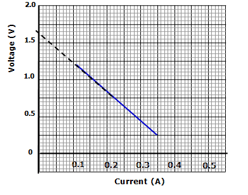INSTRUCTIONS
- This paper contain two sections; Section I and Section II.
- Answer all the questions in section I and II. In the spaces provided
- All workings and answers must be written on the question paper in the spaces provided below each question.
- Marks may be given for correct working even if the answer is wrong.
- Calculators and KNEC Mathematical tables may be used EXCEPT where stated otherwise.
- Show all the steps in your calculations, giving your answers at each stage in the spaces below each question.

QUESTIONS
SECTION A 25 MKS
- Figure 1 below shows an ammeter used to measure current flowing through a section of a conductor. The student used the upper scale.

State the reading from the meter. (1mark) - Why is it safer to carry explosive fuels in metal cans instead of plastic can? (1mark)
- What do you understand by rating 9W, 240v indicated on an energy saving electric bulb? (1mark
-
- Bulb X lights while bulb Y does not. Explain. (1mark)

- Figure 3 shows a force on a conductor carrying current when placed in a magnetic field.

State the polarities ends R and T. (1mark)
T _____________________________________________________
R _____________________________________________________
- Bulb X lights while bulb Y does not. Explain. (1mark)
- What property does a fuse wire have that make it suitable for controlling excessive currents in circuits? (1mark)
-
- The figure 4 below shows an image formed in a plane mirror.
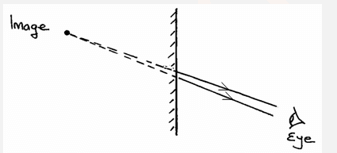
By drawing incident rays for the rays shown, locate the position of the object. (2 marks) - An object is placed 20cm in front of a convex lens of focal length 15cm. State one characteristic of the image formed. (1 mark)
- The figure 4 below shows an image formed in a plane mirror.
- Figure 6 below shows an arrangement of a cylindrical bar magnet suspended freely close and parallel to a fixed solenoid.
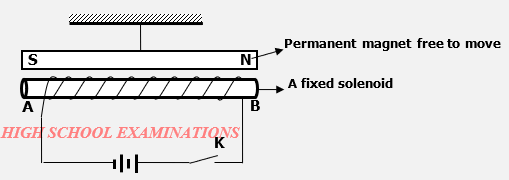
Explain what motion you are likely to observe in the arrangement when switch K is closed. (1mark) - A coin is placed at the bottom of a beaker filled with water to a height of 2.4cm as shown in the figure 7 below. Given that the refractive index of water is 1.33, determine the vertical displacement of the coin. (2 marks)
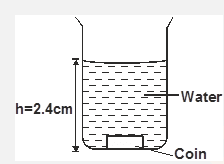
-
- The figure 8 below shows an image I formed by an object placed in front of a convex mirror. C and F are the centre of curvature and principal focus of the mirror respectively. Using appropriate rays locate the object position. (2 marks)
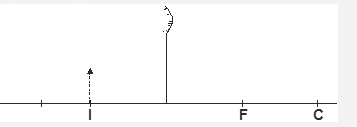
- State one difference between sound waves and electromagnetic waves (1mark)
- The figure 8 below shows an image I formed by an object placed in front of a convex mirror. C and F are the centre of curvature and principal focus of the mirror respectively. Using appropriate rays locate the object position. (2 marks)
-
- The fig 4 below shows a section of a circuit in domestic wiring.
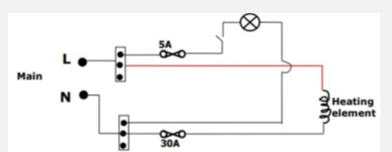
Identify one defect in the wiring. (1mark) - State one danger of high voltage transmission of electricity over long distances. (1mark)
- The fig 4 below shows a section of a circuit in domestic wiring.
- Radium22686 disintegrates into a new stable element lead 20684how many alpha and Beta particles are emitted (2marks)
- The figure 2 below shows an electroscope being charged by induction.
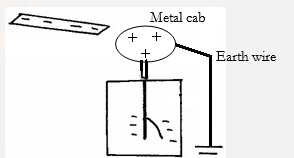
- State the reason why the cap of the electroscope is made circular.(1 mark)
- On the same diagram, show the direction of the flow of electrons on the earth wire. (1mark)
- An electric heater is found to have a resistance of 950Ω when operating normally on a 240V mains. Find the power of the heater. (2marks)
-
- The figure below shows a set up by a student investigating propagation of sound waves.
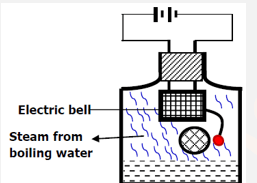
Explain what happens to the sound from the bell as the bottle and its contents are cooled to 0°C . (1mark) - In determining the depth of an ocean an echo sounder produces ultrasonic sound. Give one reason why this sound is preferred (1mark)
- The figure below shows a set up by a student investigating propagation of sound waves.
SECTION B (55 marks)
-
- he figure below shows wave fronts approaching the boundary between two media
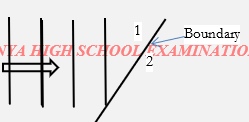
The speed of the wave in medium (1) is higher than in medium (2). On the same diagram complete the figure to show the wave fronts after crossing the boundaries (1mark) - A ray of light is incident on a glass-water interface as shown in figure 11 below.
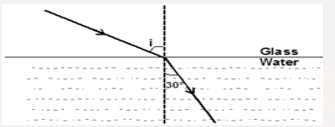
Calculate the angle of incidence i. (Take the refractive index of glass and water 3⁄2 and 4⁄3 respectively. (3 marks) - Prisms are preferred to plane mirrors for use in periscopes. State one reason for this. (1 mark
- The figure below shows a standing wave on a string of length 27cm.

Determine the wavelength of the wave. (3 marks) - The figure below shows a longitudinal wave that takes 0.32s to move from point X to Y and at a speed of 50m/s.

Calculate- the frequency of the wave (2marks)
- the wavelength of the wave (2marks)
- he figure below shows wave fronts approaching the boundary between two media
-
- State one advantage of an alkaline accumulator over lead acid accumulator. (1 mark)
- Figure below shows resistors in a circuit.
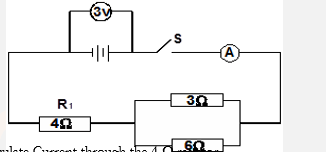
Calculate Current through the 4 resistor. (3 marks) - The graph below shows the Voltage current relationship for a certain battery.
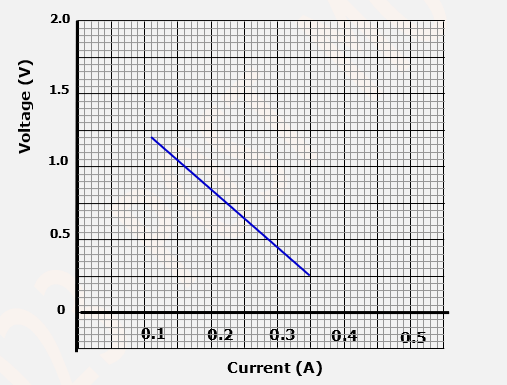
Determine:- The e.m.f of the cell. ………………………………………………… (1mark)
- The internal resistance of the cell. (3marks)
- Two coils T and S are wound on a soft iron core as shown. T has 1000 turns while S has 600 turns and resistance of 100Ω

Calculate the maximum current measured by the ammeter. (3marks)
-
- The fig. shows as simple form of cathode ray tube, which produces a sharp shadow of a Maltese cross on a fluorescent screen.
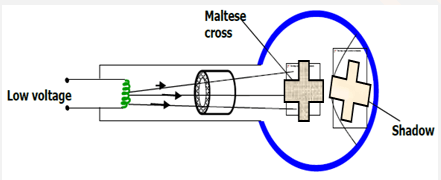
- Explain what is meant by cathode rays. (1mark)
- What property of cathode rays does the fig. above illustrate (1mark)
- State one factor that affects photoelectric emission from a given metal surface. (1mark)
- A graph of K.E of photoelectrons emitted by metal surface A against the frequency of radiation used is as shown below
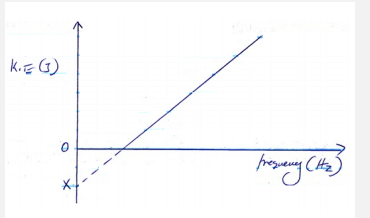
From the graph;- What is the significance of the gradient of the graph? (1mark)
- What is the significance of OX (1mark)
- The threshold frequency for potassium is 5.37 x 1014Hz. When the surface of potassium is illuminated by incident radiation from a source, photoelectrons are emitted with the speed of 7.9 x105m/s. Given that h=6.62 x 10-34 JS and me=9 x 10-31kg, calculate:
- The work function for potassium (2marks)
- The frequency of the incident radiation from the second source. (3marks)
- The fig. shows as simple form of cathode ray tube, which produces a sharp shadow of a Maltese cross on a fluorescent screen.
- Figure below shows the features of an X-ray tube.
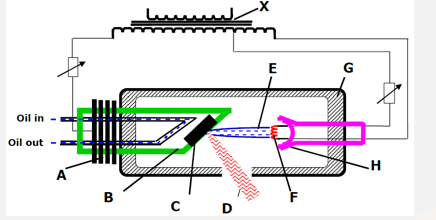
- Name the parts marked with letters A and H (2marks)
- Why is tungsten or Molybdenum metal most suitable materials for making part C (1mark)
- Why is part B made of thick copper metal (1mark)
- Why should the machine should be surrounded by material G? (1mark)
- Why is the tube evacuated? (1mark)
- What effect will increasing current at F have on x-ray produced? (1mark))
- What effect will increasing the p.d. between at B and F have on the x-rays produced (1mark)
- State one way in which cooling is achieved in this X-ray machine. (1mark)
-
- State one difference between a capacitor and a cell. (1mark)
- Sketch the electrostatic field pattern due to the arrangement of the charges shown (1mark)
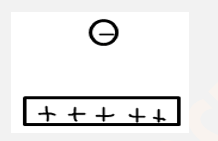
- The diagram shows a parallel plate capacitor with a dielectric material in between the plate.
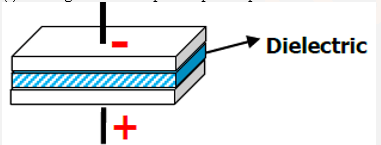
State how each of the following quantities are affected when the dielectric material is pulled out of the parallel plates.- The p.d across the plates. (1mark)
- The charge on the plates. (1mark)
- The capacitance of the system. (1mark)
- Three capacitors of 1.5µF, 2.0 µF and 3.0 µF are connected in series to p.d. of 12V. Find the total charge stored in the arrangement (3marks)
- The figure below shows a capacitor C being charged.
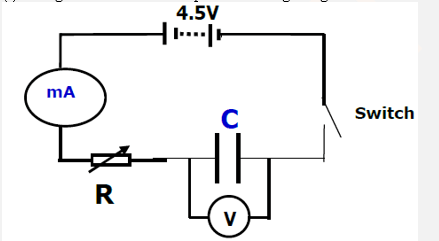
State what would be observed on the following when the switch is closed:- The milliameter (1mark)
- The voltmeter (1mark)
- Explain how the capacitor is charged. (2marks)
- On the axis provided, sketch the graph of voltage (V) against time (t) (1mark)
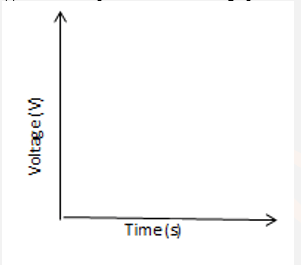
CONFIDENTIAL
Question 1
- Two dry cells and a cell holder
- An ammeter
- A voltmeter
- Metre rule mounted with a nichrome wire( 28 gauge)
- A switch
- 8 connecting wires
Question 2
- Metre rule
- A knife edge
- 50g mass and a 100g mass
- Two pieces of threads each 30 cm long
- 100 ml of Water in a beaker
- 100 ml of glycerine(Liquid L) in a beaker
- Tissue paper
- 4 optical Pins
- semi-circular glass block
- two thumb pins
- soft board
- plain papers
- Vernier calipers
MARKING SCHEME
|
1. 0.48A |
√ 1mark |
|
2. Metal cans discharge the static charges while plastic cans accumulate static charges hence can create explosion |
√ 1mark |
|
3. This means that the bulb is designed to function at maximum voltage of 240V and its energy consumption is 9W. |
√ 1mark |
|
4. (a) X is connected to a forward biased diode which makes the junction to become smaller while Y is connected to a Reverse biased diode. Diodes conduct only in forward bias. (b) T= North R= South both correct; |
√ 1mark |
|
5. It has Low melting point i.e it is made of a material with low melting point e.g thin copper wire. |
√ 1mark |
|
6. (a) i Real ii. Inverted iii.Magnified iv.Formed beyond C |
√ 1mark Correct ray
√ 1mark Object
Any one √ 1mark |
|
7. The magnet is repelled/the magnet moves away from the solenoid since south and North poles are formed at ends A and B respectively |
√ 1mark |
|
8. Refractive index = real depth |
Correct subst. √ 1mark Correct ans. With unit √ 1mark |
|
9.(a)
b)
|
√ 1mark both rays (incident and reflected)
√ 1mark Object position
Any one √ 1mark |
|
10. (a)
(b) .
|
√ 1mark
Any one √ 1mark |
|
11. 226=206+4x 4x=226-206 4x=20 X=5 86=84+2x-y 86=84+10-y y=94-86 y=8 5-alpha particles and 8- beta particles are emitted |
√ 1mark No. of α-Particles
√ 1mark No. of β-Particles (Marks independent) |
|
12. ..i. For even distribution of charges ii) Upwards |
√ 1mark
√ 1mark (Allow Upwards along earth wire) |
|
13. P = V²/R. P = 240²/950 = 60.63W |
√ 1mark Correct subst. √ 1mark Correct ans. With unit |
|
14. .(a)
(The temperature of the air inside decreases, energy of the molecules decrease hence the rate of vibration decreases) (b) -Ultrasound penetrates the deepest and -can be easily reflected by tiny grains. |
√ 1mark (Deny-No sound is heard)
Any one √ 1mark |
|
15. (a) ∩gsin θ1 = ∩sinθ2 sin i = 4/3 sin 30 × 2/3 =0.4444 (b) i=29.32° |
a) √ 1mark( Refraction tied to smaller-wavelength, uniform wave fronts) b) √ 1mark- formula &/or √ 1mark -Correct subst. √ 1mark- Correct ans. with unit
|
|
15 (c)
|
√ 1mark- any one
|
|
(d) 1.5 l is proportional to 27.0cm 1λ= x |
√ 1mark- proportionality
√ 1mark -Correct subst. √ 1mark- Correct ans. with unit |
|
e)(i) f=1/T T = 0.32/4 = 0.08 f = 1/0.08 = 12.5 Hz |
√ 1mark –T √ 1mark - Correct ans. |
|
e)(ii) c=λf λ= c/f = 50 =4m |
√ 1mark -Correct subst.
√ 1mark- Correct ans. |
|
16. . (a)
|
√ 1mark- any one
|
|
b) |
√ 1mark –Total resistance
√ 1mark-Subst. for I=V/R
√ 1mark- Correct ans. |
|
c(i) 1.65V |
√ 1mark- correct value of e.m.f
(Allow value indicated on the extrapolated graph) |
|
ii) E = V + Ir V= -Ir +E -r = slope -r=3.93Ω Internal resistance =3.93Ω |
√ √ 2marks-slope
√ 1mark- relating slope with r and correct value |
|
iii Ns = Vs = IsxR |
√ 1mark- formula &/or √ 1mark -Correct subst. √ 1mark- Correct ans. with unit |
|
17. a)(i) Cathode rays are streams of electrons emitted from the surface of a metal by thermionic emission ii) They travel in straight lines (Other property) They cause fluorescent surfaces to glow (b) i) Intensity of radiation ii) Energy of radiation iii) Type of metal (c) (i) The slope represents the value of the Planck’s constant h (ii) The region OX represents the value of Work function Wo in Joules (d) i) Wo = hfo = 6.62 x 10-34 x 5.37 x 1014 = 3.55 x 10-59J (ii) K.E = ½ mev2 = ½ x 9 x 10-31 x (7.9 X 105)2 = 2.808 x 10-19J hf = Wo + K.E
|
√ 1mark-
√ 1mark-
√ 1mark- Any one
√ 1mark- √ 1mark- √ 1mark -Correct subst. √ 1mark- Correct ans. with unit
√ 1mark –K.E √ 1mark –Subst. in Einstein’s equation
√ 1mark- Correct ans.
|
|
18 a) A. Cooling fins H. Cathode b) Tungsten or molybdenum has high melting point to withstand high temperatures. c) To ensure efficient dissipation of heat. d) To absorb the stray x-ray radiations which would otherwise affect the x ray tube operators e) To prevent electrons from losing energy due to collisions with air molecules and ionization. f) The temperature of the cathode increases. This increases the number of electrons released hence the intensity of x-rays. g) Hard x-rays of very short wavelengths are produced. h) By efficient cooling fins on the outside of the tube. By circulating oil through the channels in the copper anode. |
√ 1mark-√ 1mark-
√ 1mark- √ 1mark- √ 1mark- √ 1mark- √ 1mark- √ 1mark- √ 1mark- |
|
19 a)
b) c) (i) P.d increases. (ii) Charge remains unchanged. (iii) Capacitance decreases. d) 1⁄Cs = 1/C1+1/C2+1/C3 e) i)Milliameter reading which is initially high gradually reduces to zero. ii) Voltmeter reading increases from zero to maximum value (4.5V). iii) .
|
√ 1mark- Any one
1mark- (Direction tied to shape of the field lines)
√ 1mark- √ 1mark- √ 1mark-
√ 1mark-Capacitance √ 1mark -Correct subst. Q=CV √ 1mark- Correct ans. √ 1mark –
√ 1mark – √ 1mark √ 1mark |
|
c) |
√ 1mark- Smooth curve flattening for max. voltage |
Download Physics Paper 2 Questions and Answers - Kenya High Post Mock 2023 Exams.
Tap Here to Download for 50/-
Get on WhatsApp for 50/-
Why download?
- ✔ To read offline at any time.
- ✔ To Print at your convenience
- ✔ Share Easily with Friends / Students




